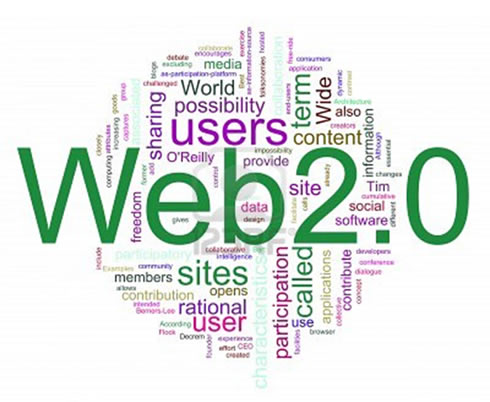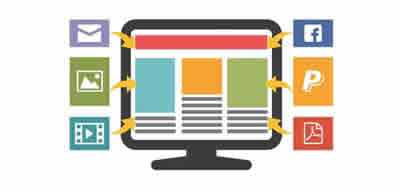Web 2.0 history, evolution and characteristics
Web 2.0 is the second generation of services on the Web, which emphasizes online collaboration, connectivity and sharing content among users.

The World Wide Web, as it is known today, was born in the early 1990s and initially offered only textual content grouped in thefamous or hyperlinks.
At this time there was muchtalkabout the birth of hypertext as a concept and Web browsing.
However, anowadays, we are far from that time.Just visit any of our favorite websites to realice that.
Websites are no longer just text and hyperlinks.
They are images, Flash animations, advertising thatbothers reading, popup windows, videos, games and complete applications.
The information no longer has exclusivity in the world of Internet; inthepresentwe use italsotopurchase, maintain our social life, manage our spreadsheets or publish our videos.
That is why the Web as we knew it has changed. A new Webappeared,the Web 2.0
Whatis Web 2.0?
We could define Web 2.0 as it follows:
"It refers to the perceived Internet transition from traditional websites to Web applications for users".
Others define it as a new social movement on the Internet, some as the new wave of services and, themore technical, as the ability to evade the original limitations of HTML.
The truth is thatit's a bit of all of that and more. It’s an open concept that encompasses three main ideas:
- Rich Internet Applications
- Semantic Web
- Social Media
History
The term Web 2.0 has a clear origin: was first used by O'Reilly Media (known for being a techbookpublishing) at a conference in October 2004.
Months later was Tim O'Reilly, founder of the company, who defined the concept and made it known in the community.
Even before the term became commonly used, O'Reilly had trademarked, which gave some headaches to other companies that tried to use it.

Concept diagram associated with Web 2.0
At that time O'Reilly’s definition included:
- The Web as a platform
- Network effects in an architecture of participation
- Innovation and independent developers
- Small business models able to publish services and content
- Open data
- Perpetual beta
Thus we see how many concepts are clusteredaround the term, and each has its part of truth.
Web 2.0 is a second generation of Web-based services, which emphasizes online collaboration, connectivity and the ability to share content among users.
Web 2.0 involves the evolution of digital applications to wards applications aimed to the end user, which include services such as social networks, wiki blogs and folksonomies.
Blog
The weblog, also called blog or binnacle, is a regularly updated website that collects chronological texts and articles from one or more authors with the most recent appearing first, with a particular topic and where the author is free to publish whathe deems necessary.
Weblogs are personal, journalistic, business or corporate, technological and educational type, among others.
The modern blog is an evolution of online journals where people wrote personal life. Justin Hall, who in 1994 wrote for eleven years his personal blog while a student at Swarthmore University, is recognized as one of the first bloggers.
There are different and various blog maintenancetoolsthat, for free and without high technical skills allow you to manage all the weblog, coordinate, delete or rewrite the articles and moderate comments from readers, as simply as manage an email.
Currently its use has been simplified to the point that almost any user is able to create and manage a blog.
The weblogs maintenance tools ismainly classified into two types; theones that offer a complete hosting solution for free likeBloggers, and those solutions involving software that when installed in a website, allowsto create, edit and manage a blog directly on the server hosting the site, as is the case of WordPress.
This software is a variant of tools called Content Management Systems whose acronymis CMS (Content Manager System) and many are also free.
The mixture of the two types is the solution proposed by the multiuser version Wordpress.
The tools that provide free accommodation assign to the user a Web address. For Bloggers, the assigned address ends in blogspot.com and provides an interface through which it is possible to add and edit content.
However, the functionality of a blog created with one of these tools is limited to what the service providercan offer.
Note that thesoftware that manages the content necessarily requires its own server to install, just as it’s done for a traditional website.
Its great advantage is that it allows full control of the functionalitythat the blogwilloffer and that it can be adapted to the needs of the site, and even combine it with some other contents.
Some elements are common on weblogs, such as lists of links to other weblogs, also called webroll.
Additionally you can have a log file or previous posts, permanent links for anyone to cite a memo or a post following the link or function to add comments, among others.
A feature that sets them apart from news sites is that annotations or posts usually are necessarilyweblogs, such as references to expand added information.
Wiki
(From the Hawaiian Wiki, meaning fast). It is a collaborative web site made by various users who can create, edit, delete or modify the contents of a Web page interactively, easily and quickly.
These facilities make the wiki an effective tool for collaborative writing. Currently, the largest that exists is the English version of Wikipedia.
Folksonomy
Term derivedfrom taxonomy (Greek "taxis" classification and "nomo", order and manage) and floc (German "Volks" people). Consequently, folksonomy means literally classificationrun by the people.
This concept is a neologism to collaborative categorization using simple tags in a flat name space without hierarchies or predetermined kinship relations. Compared with other systems of categorization, such as Gmail, which also uses tags, it is distinguished that users share categorizations.
Folksonomies originates when multiple users collaborate in describing the same informatic material.
They are basically content labeling systems.
Web 2.0 is a change in the way of thinking, design and use the Internet, supported by new technologies, in which it evolves from a Web of reading into a read/write.
In the previous model (Web 1.0), the information was generated by publishers and webmasters, anditwas consumed by users. In the new model, the information is generated directly or indirectly by users and shared by the sites.
In general, we could say that the pillars on which this new concept is based are the technologies, social networks, content syndication, Web services and software service.
Evidently, this new vision of the Internet brings with it a group of new technologies among which are:
Cascading Style Sheets (CSS) Formal language used to define the presentation of a structured document written in HTML, XML or XHTM or HTML5.
Microformats. These are marks used to include semantic expressions in a Web page, which allows to extract its meaning.
Itoriginates from the work of the developer community Technorati, which aims to standardize a set of formats in which to store basic knowledge.
The main limitation is that each type of meaning requires the definition of a specific microformat, which are:
- hCalendar: forevents and dates
- hCard: forcontactinformation
- hReview: foroptions
- Rel-directory: forthecreation of distributeddirectories
- Rel-nofollow: to specify that a hyperlink with this attribute should not intervene in the analysis by search robots like google
- Rel-tag: for decentralized labeling
- Xfolk: for link labeling
- XFN: for social relations
- XOXO: forlists
Non-intrusiverichapplicationstechniques such as AJAX (Asynchronous JavaScript And XML), combination of technologies that allow a certain Web to communicate with the server in the background, responding to events without having to reload the page.
In this way, the Web pages are more agile and dynamic, and seem increasingly to desktop applications.
Content syndication through feeds, which are generated by some unionized sites containing a specific version of the information posted on them so they can use the information to add files.
RSS (Rich Site Summary, RDF Site Summary, Really Simple Syndication) and Atom are the most commonly used data formats to syndicate or distribute content to subscribers to a website.
Generally speaking, these systems allow a Webto export its contents and otherstoimportthemdynamically.
The contents can be:
- Written (blogs, news daily, telematic portals ...)
- Audio (podcast)
- Photographic (or any service like Flickr photoblog)
- Audiovisual (any videoblog or services like You Tube)
Interactivity on the Web
One of the biggest differences of theInternetwithother media is interactivity.
Interactivity is one aspect to be taken into consideration in the web design, because of the relationship with the market; when the client can choose and test a service or product thereis a sale.
And it is precisely thanks to the market that inversions in the growth of the networkhavebeenmade.
NOTE:
The user-client of a page is not a passive object, it becomes a great informer. When theycomplete data on a form, answer a survey, use e-mail or access to a procurement system they’re interacting on the Web.
The process off inding information largely reflects the interactivity of the Web.
These processes constitute a real challenge for designers, because the more sophisticated tool sare, the harder it is to find the limitof the possibilities.
Online games areother examples of Web interactivity. They are games that are played via the Internet.
The main difference about the consoleor computer games is that they are normally platform independent, based solely onclient-side technologies, called plugins or players.
Advantages of Web 2.0 applications
Web 2.0 applications allow to perform the same as the desktop but with the follow ing improvements:
- Centralizing customer information in a single secure database
- Storage of informationon secure servers against theft, fire, power outage, etc.
- Compatibility with any device witha browser like PC, SmartPhones, PDAs, game consoles, etc.
- Ability to workinmultiple parallel users sharing the same data in real time
Summary
The Internet world grows quickly. Thousands of sites and new users arise and the study to ensure the speed of sending and reception of data with the latest technology is ensured.
The development of new technologies will result that in a relatively short time their Web pages will be see neven by people who have never touched a computer.
CITE ARTICLE
For homework, research, thesis, books, magazines, blogs or academic articles
APA Format Reference:
Delgado, Hugo. (2019).
Web 2.0 history, evolution and characteristics.
Retrieved Nov 23, 2025, from
https://disenowebakus.net/en/web-2






